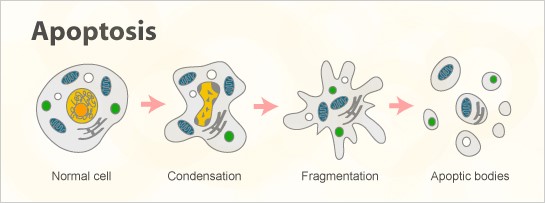Apoptosis
The ability to modulate the life or death of a cell has a huge therapeutic potential. When apoptosis works overly well, too many cells may die and the result may be grave tissue damage. This is the case in neurodegenerative disorders such as Alzheimer, Huntington and Parkinson diseases. On the other hand, when apoptosis does not work, cells become immortal as occurs in cancer. Therefore, analysis of the cell cycle machinery and signaling pathways that control the cell cycle is widely studied.
In the following article, the most important research tools for apoptosis available at Szabo-Scandic will be described.
During the early stage of apoptosis, the loss of cell membrane asymmetry will take place. In this stage, the embedded Phosphatidylserine (PS) residues in the plasma membrane is translocated. Annexin V is a Ca2+ dependent phospholipid-binding protein that has a high affinity for PS and can be used for identification of cells in the early stages of apoptosis. Our suppliers Immunostep and GeneTex have developed Annexin V Apoptosis Detection Kits for flow cytometry with different fluorochrome variants.
Changes in the mitochondrial potential have been described during necrosis, cell cycle and apoptosis. Mitochondrial uptake of dye is a possible source of fluorescence variance. Flow cytometry can be used to estimate membrane potential in eukaryotic cells. Immunostep MitoStep Kit uses a cationic dye DilC1.
Apoptosis is the result of a cascade of molecular and biochemical events involving endogenous endonucleases that cleave DNA into the prototypical ladder of DNA fragments that may be visualized in agarose gels.
Exalpha’s DNA Fragmentation Detection Kit exploits the fact that apoptotic endonucleases not only affect cellular DNA by producing the classical DNA ladder but also generate free 3’-OH groups at the ends of these DNA fragments. These free 3’-OH groups are end-labeled by the DNA Fragmentation Detection Kit allowing for the detection of apoptotic cells using a molecular biology-based, end-labeling technique.
Evaluation of cell cycle progression is essential for investigations in many scientific fields. The BrdU Chemiluminescent Cell Proliferation Assay Kit and BrdU Cell Proliferation Assay Kit are non-isotopic enzyme immunoassay for the quantification of DNA synthesis and cell proliferation. These kits involves incorporation of BrdU reagent into cells cultured in microtiter plates using the cell layer as the solid phase. The resultant assay is rapid, easy to perform and applicable to high sample throughput. The BrdU Immunohistochemistry Kit is a histochemical staining kit for the detection and localization of bromodeoxyuridine incorporated into newly synthesized DNA of actively proliferating cells.
The Tunel Assay Kit (Elabscience) is a highly sensitive, rapid and simple method for cell apoptosis detection. After Biotin-dUTP labeling and DAB staining, cell apoptosis can be detected under ordinary optical microscopy.
See DNA Damage ELISA Kits were you can find more enzyme-linked immunosorbent assay for the quantitative measurement of DNA and RNA.

Caspases can be divided into three groups: initiator caspases (caspase 2, 8, 9 and 10), effector caspases (caspase 3, 6 and 7), and inflammatory caspases (caspase 1, 4, 5, 11 and 12). Initiator caspases cleave the effector caspases, which are responsible for the cleavage of the key cellular proteins, such as cytoskeletal proteins, that lead to the typical morphological changes observed in cells undergoing apoptosis. Inflammatory caspases do not function in apoptosis but are associated with immune responses to microbial pathogen and promote pyroptosis, another type of lytic cell death that is associated with the secretion of the inflammatory cytokines.
Szabo-Scandic offers a broad range of antibodies, proteins and kits for caspase-involved research. The Caspase Inhibitor Screening Kits are used for screening caspase inhibitors using fluorometric methods.
Caspase 3 cleaves and activates Caspases 6, 7 and 9. It is the predominant caspase involved in the cleavage of amyloid-beta 4A precursor protein, which is associated with neuronal death in Alzheimer's disease. Caspase 6 is processed by Caspases 7, 8 and 10, and it is thought to function as a downstream enzyme in the caspase activation cascade.
Protein p53 is known to act as a tumor suppressor in many tumor types. P53 can induce growth arrest or apoptosis depending on the physiological circumstances and cell type. Szabo-Scandic can provide you with a large variety of p53 Antibodies for your research.
GeneTex offers Antibody Panels for general apoptosis research including the most important antibodies.
Santa Cruz Biotechnology has a wide choice of apoptosis research antibodies available in different conjugations, e.g. BCL-2 Antibodies, Bax Antibodies, Ras Antibodies, Rock-1 Antibodies or AIF Antibodies.
Detection Kits and Related Reagents:
|
Caspase 1 - Caspase 4 - Caspase 5 - Caspase 11 - Caspase 12 |
|

 Deutsch
Deutsch


